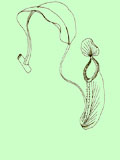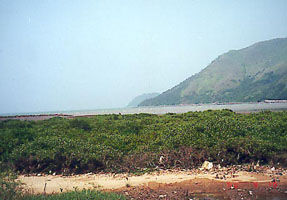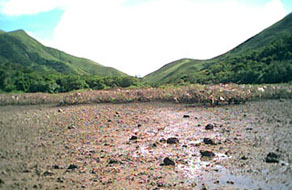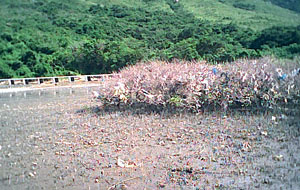

 |
 |
 |
Feedback
![]() Don't
Stone the House Crows (More on alien invaders)
Don't
Stone the House Crows (More on alien invaders)
![]() Common
Names of Mammals of the World
Common
Names of Mammals of the World
![]()
Don’t Stone the House Crows (More on alien invaders)
Dear Feedback,
In the article on Hong Kong’s Bad Biodiversity (Porcupine 23) Richard Corlett points out that most urban exotics are doing no obvious harm and some contribute positively to the quality of city life. Nevertheless, he went on to conclude that in view of the risk from ‘invasive species’ (species which become established in natural and semi-natural environment) we need a system by which newly established exotics are identified, reported and, if possible, exterminated, before they can spread. Whilst I do not disagree with any of Richard Corlett’s account of exotics in Hong Kong I think his final recommendation is unjustified. It should be applicable only to those species with the potential to cause large economic losses or severe ecological damage but unwarranted for the vast majority of harmless exotics, especially in an urban setting.
One point, which should be clearly recognised, is that man has highly modified the local environment, creating conditions, which allow exotics to become established. Our heavily disturbed local ecosystem lacks biodiversity, relative to its natural, mostly forest condition. Urban areas and much of Hong Kong’s rural environment are prone to domination by a few species, either local or exotic in origin. Even a local species can become a pest if you create the perfect environment for it.
As part of continental Asia, China already possesses a robust fauna and flora, which is not especially susceptible to ‘invasive species’. Remote areas, isolated islands and even isolated continents such as Australia, possessing naive faunas are at high risk from alien invasion but here the local fauna and flora is probably at a lower risk from exotics than most other ecosystems on earth. However, when habitats are simplified they become susceptible to colonisation by exotics. Also when species are over-exploited a niche is created for invasion by an exotic.
At Tai Po Kau Forest, which is a secondary forest about forty years old, we have witnessed the steady colonisation of fauna and flora. Whilst many southern Guangdong native birds, such as Rufous-capped Babbler and Chestnut Bulbul, have recolonised there are several non-native birds, which have established breeding populations, such as Silver-eared Mesia and Blue-winged Minla. These latter Asian birds, with distributions including China but not Hong Kong, are taken from the wild and are freely traded at Hong Kong’s bird markets. Should we control the flourishing trade in exotic birds to prevent introduction of exotics? No identifiable ecological damaged has been reported arising from colonisation in Hong Kong by exotics birds (apart from damage to exotic trees by Lesser Sulphur-crested Cockatoos). If there are no good examples to cite it is difficult to make a compelling argument to control the bird trade on these grounds. It should be noted that under the Animals and Plants (Protection of Endangered Species) Ordinance, measures are already in place to control trade in scheduled species.
Even if birds were not traded some birds would still manage to find their way here by the many routes made available in today’s global marketplace. For several years I have observed House Crows in and around the docks at West Kowloon. In July this year I observed a family of House Crows raise four fledglings in Tonkin Street West, Sham Shui Po. This represents the first breeding record for this species in Hong Kong. These birds undoubtedly arrived on container vessels on passage from Celon or India where House Crows are abundant in lowland, urban areas. Here, the native Jungle Crow prefers open country of peaks and forest. Another native crow, the Collared Crow, prefers the open lowland environment associated with the fish pond areas and Deep Bay in the northern New Territories. Hong Kong’s two native crows appear to avoid lowland, urban environments. There appears to be nothing to gain from exterminating House Crows since it is relatively harmless and we have created the perfect environment for this tropical, Asian species and furthermore have unwittingly provided the transport means for it to arrive here.
Some forest birds also find Hong Kong’s urban environments to their liking. Indian Crackles, a popular cage bird, successfully bred in Hong Kong Park in 1999 and 2000. Another bird, which certainly could not be described as bad biodiversity, is the Lesser Sulphur-crested Cockatoo; a threatened bird from Indonesia, which has one of the largest remaining populations occurring here in urban Hong Kong. We would be doing a grave disservice to the planet’s biodiversity if we embarked on a programme to exterminate this exotic parrot here in Hong Kong.
I am not advocating that we should purposely encourage the establishment of exotics but they should be viewed in the context of man’s conversion of the countryside into a highly modified environment. Indeed most of man’s choice of plants to grow as agricultural produce are exotics.
In the marine environment the fish Red drum, Sciaenops ocellatus, appears to have become established in Hong Kong waters. I have encountered it on several occasions during 2000, whilst diving using a rebreather, in an apparently wild state, both in shoals and as individual fish. This fish is extensively cultured in southern China and Hong Kong as a mariculture food fish. The risks this western Atlantic fish poses to Indo-Pacific populations are unknown but now it is here there seems to be no point in trying to eradicate it. Any effort would be futile.
Red drum is a large croaker, which can grow rapidly to 1.5 m with a maximum weight of 45 kg. One can’t help surmise that the local extirpation, of the similarly sized 1.5 metre Chinese croaker, Bahaba taipingensis, which is restricted to South China, has facilitated the spread of this exotic. Red drum are freely available from hatchery facilities developed in the USA. I am not aware of any attempt to grow Chinese croaker but Giant Grouper a local Indo-pacific species considered under threat from the reef fish trade is now freely available and is being cultured in large numbers in China and Taiwan. This type of culture should be encouraged but the decision to culture exotic Red drum in marine sea cages, where the inevitable escapees will enter ideal conditions to thrive, was unwise.
The presence of South American Fire ants, Solenopsis invicta, in Australia is another matter. The Australians are currently launching a major A$100 million, five-year campaign to rid themselves of this aggressive exotic, and prevent it from becoming an ‘invasive’ species. It has already established populations in some 40,000 ha around Brisbane, and according to recent estimates, has the potential to cause damage in excess of A$ 100 billion over the next 30 years. However, according to Bert Candusio (New Scientist: 17.XI.2001), curator of the Insectarium of Victoria near Melbourne, "Going on past experiences, fire ants will not be eradicated from Australia". Attempts in the USA have failed and similar attempts in Australia to eradicate the Argentine ant, Linepithema humile have failed. Ants probably arrived in Australia in soils associated with imported pot plants.
The message here again is that preventive measures to stop unwanted aliens arriving in the first place are the most expedient. We will not be able to exterminate exotic species without spending enormous sums of money and the eradication treatment itself may have adverse impacts on local species. Agriculture, Fisheries and Conservation Department (AFCD) already has measures in place to restrict the importation of plants with associated soils. A phytosanitary certificate is required before plant imports can be accepted under the Plant (Importation and Pest Control) Ordinance.
Apart from preventative measures to prevent introduction of exotics the priority for protection of local fauna and flora should be to conserve the best examples of remaining natural or semi-natural habitats. By far the biggest threat to these habitats comes not from exotics but from developmental pressures, pollution or fire. These threats should remain the main focus of effort to protect Hong Kong’s biodiversity.
Keith Wilson, Hong Kong
E-mail: wilsonhk@hk.super.net
| P.3-4 |
![]()
Common Names of Mammals of the World
Dear Feedback,
There is a new book called "Common Names of Mammals of the World" (Washington: Smithsonian University Press, 2000) by Wilson & Cole, which gives English names for every species of mammal. They use Sikkim Rat for Rattus sikkimensis and I suggest in the interests of stability in use of English names that there is no strong reason not to follow it in Hong Kong.
Andrew Duff, Somerset U.K.
E-mail: andrew.duff@virgin.net
| P.4 |
![]()
The mangrove in Yi O
Dear Feedback,
Recently, Ming Pao reported that the Yi O villagers on Lantau Island had decided to close two footpaths in their village starting from late November. One of these footpaths leads to the Yi O mangrove. A village representative said the move was to prevent Yi O from becoming the second Long Valley as some environmentalists had planted mangroves on his land.
I visited the mangrove at Yi O in July. It was a shock as I found most mangrove trees dead or dying. All Avicennia marina, the dominant tree species of the Yi O mangrove, had lost their leaves and had no signs of life.
Yi O is a small mangrove located on southeast Lantau Island, mainly composed of Avicennia marina, Kandelia candel and Aegiceras corniculatum. Acanthus ilicifolius and Bruguiera gymnorrhiza, although relatively rare, are also found. Epiphytic fauna, e.g. Littoraria species, are abundant. Compared to the pictures taken in the summer of 2000, the recent photo taken in the mangrove is like a scene from ‘Sleepy Hollow’. (Figures 1 and 2)
According to Ming Pao and The Sun (1 Jun 2001), most Avicennia marina trees at the mangrove were damaged by moth larvae, whilst other mangrove species were not affected. Shocking news was reported, two months after the natural disaster occurred, when about 200 mangrove trees were chopped off, burnt or splashed with oil (Ming Pao, Apple Daily, The Sun, 23 Jul 2001). Live mangrove no longer exists. What is left in the mangrove are several littorinids attached to the bald canopy, and a few small mudskippers and crabs on the mudflat. Who is the murderer of these trees? Is there someone who hates moths very much and wants to destroy the moth population by depleting all potential food items of the moth larvae? Or someone who doesn’t want the mangrove to exist anymore as he thinks conservation of the mangrove will conflict with his indigenous rights?
Under the Forests and Countryside Ordinance, any person who, without lawful authority or excuse, in any forest or plantation, plucks or damages any bud, blossom of leaf of any tree, shrub or plant shall be guilty of an offence. We need Sherlock Holmes, in the 21st century, to find the murderer!
 |
 |
|
Fig.1. Yi O mangrove in September 2000. |
|
 |
 |
|
Fig.2. Photos taken in the same place in July 2001. |
|
Olive Lee, Hong Kong
E-mail: a9416396@graduate.hku.hk
| P.4-5 |
|
Porcupine! |
 Copyright © 2000 |